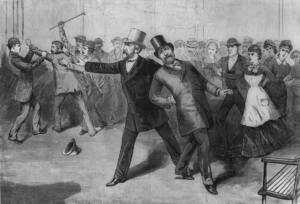The Assassination of
President James A. Garfield

Unlike other presidential assassinations, the assassination of James A. Garfield is typically the least talked about. Garfield was only in office for four months when Charles Guiteau shot him in plain sight on July 2, 1881.
Charles Guiteau is often referred to as a true failure after attempting several career paths and failing at all of them. He finally turned to politics during the time of the Spoil System, where elected officials could grant government civil service jobs to petitioning individuals regardless of ability. Guiteau believed he should be the Minister to France. After several failed trips to the White House to be appointed, he had what he called a “Divine Inspiration,” in which God told him he needed to kill the president.
Garfield was on his way to his summer vacation with his sons, leaving for Massachusetts from the Baltimore and Potomac Railroad Station in Washington D.C. Early presidents did not have Secret Service or other security precautions at the same levels they do now, thus making them vulnerable targets when out in public. The news of the president’s upcoming travel was public information, Guiteau simply waited in the station’s lobby for Garfield to arrive and stepped out of the shadows to shoot him at point-blank range. Guiteau fired two shots, one hitting Garfield in the arm and one in the back. Neither shot, however, was fatal. The bullets did not hit any vital organs. In an attempt to help the wounded president, several people gathered around Garfield to aid to his wounds. Several men attempted to remove the bullet from Garfield’s body by poking and prodding at his open wounds with unsanitized hands. Precautions about germs and infections were not understood to the degree they are now. For many days after the shooting, several doctors attempted to locate and remove the bullets from Garfield’s body with no success.
Unfortunately, due to all of the exposure to germs, Garfield developed an infection and became very ill. He remained bedridden while his heart became weaker, and he began to lose weight. On September 19, 1881 — 79 days after the shooting — President Garfield died of a ruptured splenic artery aneurysm due to sepsis and pneumonia. It is believed that Garfield probably would have survived his wounds had he been treated properly.
On the day of the attack, Guiteau was apprehended at the scene and was put on trial in November 1881. The trial received extensive media attention for Guiteau’s bizarre behavior throughout. He pleaded not guilty, claiming his actions were the will of God and he was merely an instrument of it. During the trial, Guiteau attempted to argue that he did not kill Garfield, rather it was the president’s doctors. He admitted to shooting the president, but he claimed his ultimate demise was a result of his treatment.
On January 25, 1882, Charles Guiteau was found guilty of the assassination of President James Garfield. Guiteau attempted to appeal the case, but his appeal was rejected and he was sentenced to be executed by hanging. Guiteau was executed on June 30, 1882, less than a year after the shooting. Guiteau danced to the gallows and recited a poem, before waving to the crowd, and shaking hands with the executioner.
Back to Assassinations
Back to Crime Library
|
|
|

